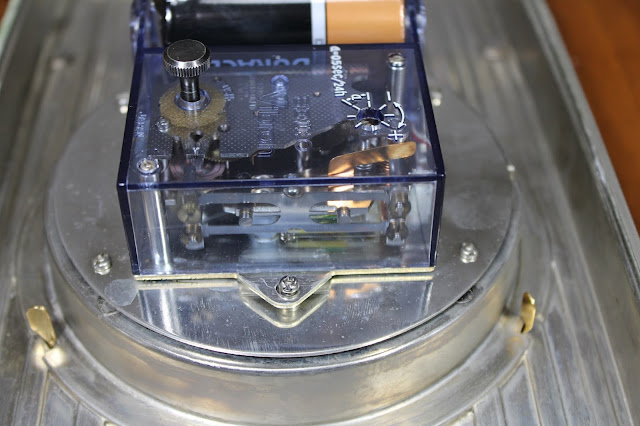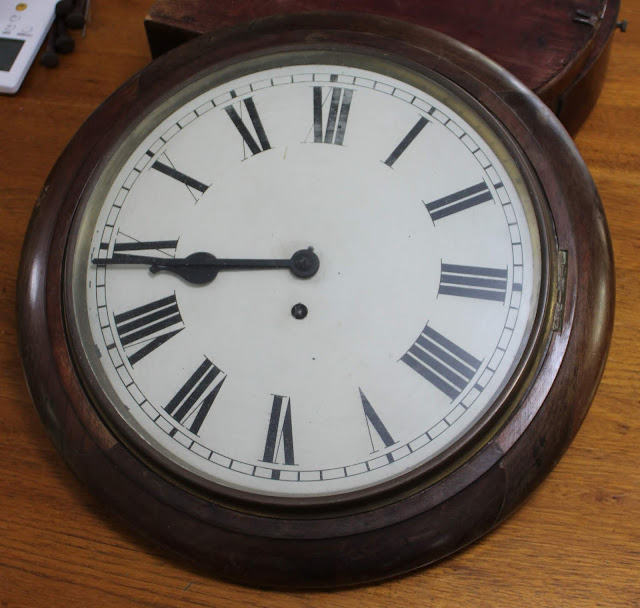Hebei Yuxuan Classical Clock Company Reproduction Antique Skeleton Great-Wheel Clock
Significance
A reproduction antique skeleton great-wheel fusee clock by the Hebei Yuxuan Classical Clock Company of China. Hebei Yuxuan specialises in the accurate reproduction of antique clocks, currently producing about 400 different models and employing 300 people. Often dismissed as a "deceptive, cheap Asian copy", the company itself is quite clear on its purpose, high-quality reproductions and in the style of antique clocks. It seems to be more a problem of resellers purporting to be selling originals or the work of local, western artisan clockmakers.
The clock seems to be high-quality work, in the style of French great-wheel, skeleton, fusee clocks popular in the mid-1800s. The clock seems capable of accurate timekeeping given five jewels, a fusee and the great wheel to reduce friction. Further, it is very attractive with a gold-plated finish in glass and polished timber case.
Reproduction clocks have an important part in the market for both clock collectors and ordinary consumers wanting attractive decorative clocks. There seem to be four major groups producing mechanical clocks in the style of earlier clocks.
The first is the likes of the Hebei Yuxuan Classical Clock Company of China (only one??). They seek to produce high-quality reproductions of antique clocks for domestic and global markets. They make 120,000 clocks annually, across 400 models.
Hebei Yuxuan Classical Clock Company English website: http://www.art-clock.com/English/
A clock with the same mechanism as mine:
Discussion
Few collectors can afford popular original antique clocks such as a mid-1800s French great-wheel clock. The alternatives are reproduction clocks made in the style of the antique clocks. I couldn't even afford a new reproduction and settled for a used one on eBay for a few hundred dollars.Reproduction clocks have an important part in the market for both clock collectors and ordinary consumers wanting attractive decorative clocks. There seem to be four major groups producing mechanical clocks in the style of earlier clocks.
The first is the likes of the Hebei Yuxuan Classical Clock Company of China (only one??). They seek to produce high-quality reproductions of antique clocks for domestic and global markets. They make 120,000 clocks annually, across 400 models.
Hebei Yuxuan Classical Clock Company English website: http://www.art-clock.com/English/
A clock with the same mechanism as mine:
http://www.art-clock.com/SkeletonClock/product_1319.html

A measure of the cost of producing such is their relatively high cost even in the domestic Chinese market such as advertised on Taobao, the internal Chinese eBay. A clock very similar to mine, same mechanism but a metal rather than wood and glass case, is advertised for CNY2780, about US$400 (https://item.taobao.com/item.htm?id=38266330260).

Clock collectors may be interested in purchasing directly from China and can do so either directly from Taobao, using Google translation (assuming no fluency in Chinese), or through English-language buying services (Taobao FOCUS (https://tbfocus.com/), similar to services for purchases outside of the USA or Japan ( https://www.myus.com/ or https://buyee.jp/)
The second group consists of retail clock shops that seem to be purchasing reproduction clocks from Hebei Yuxuan (or similar) but with their own case design and seemingly a very substantial markup of the retail cost. For instance, O. Comitti & Son Ltd of London have a range of "Mayfair" clocks that seem to have the same mechanism as mine, but sell for about GBP9000 pounds or about USD$11000, a big markup of the USD$400 on Taobao! Perhaps the thinking is in error, with the Chinese company copying the British design, I don't know. Similarly, there are many sellers on eBay that are either unaware or deliberately don't mention of a clock's country of origin.
Comitti's Mayfair range: https://comitti.com/collections/mayfair Comitti has a number of ranges of similar high-quality reproduction clocks. Very pretty, but very expensive.

A measure of the cost of producing such is their relatively high cost even in the domestic Chinese market such as advertised on Taobao, the internal Chinese eBay. A clock very similar to mine, same mechanism but a metal rather than wood and glass case, is advertised for CNY2780, about US$400 (https://item.taobao.com/item.htm?id=38266330260).

Clock collectors may be interested in purchasing directly from China and can do so either directly from Taobao, using Google translation (assuming no fluency in Chinese), or through English-language buying services (Taobao FOCUS (https://tbfocus.com/), similar to services for purchases outside of the USA or Japan ( https://www.myus.com/ or https://buyee.jp/)
The second group consists of retail clock shops that seem to be purchasing reproduction clocks from Hebei Yuxuan (or similar) but with their own case design and seemingly a very substantial markup of the retail cost. For instance, O. Comitti & Son Ltd of London have a range of "Mayfair" clocks that seem to have the same mechanism as mine, but sell for about GBP9000 pounds or about USD$11000, a big markup of the USD$400 on Taobao! Perhaps the thinking is in error, with the Chinese company copying the British design, I don't know. Similarly, there are many sellers on eBay that are either unaware or deliberately don't mention of a clock's country of origin.
Comitti's Mayfair range: https://comitti.com/collections/mayfair Comitti has a number of ranges of similar high-quality reproduction clocks. Very pretty, but very expensive.

Third, are artisan clockmakers in the antique style. Dent & Co, London, and others. If you need to ask the price, you can't afford it!
The fourth group are the long-term manufacturers of clocks, still making some in the antique or veteran styles, including Hermle, Kieninger (Germany), Howard Miller (USA), cost US$2000++.
Finally, some idea of the real antique French skeleton, great-wheel clocks costing maybe US$10k+.
Description
The clock is based on the French mid-1880s fusee, skeleton, great-wheel clock. The great wheel reduces the need for one wheel (gear) to reduce friction but increases the size. The wire fusee evens out the tension of the spring between fully-wound and almost unwound. Five jewels are used to again reduce friction. A Graham or Deadbeat escapement is used; now 300 years old but still in use in modern clocks. As such, the clock is quite accurate and runs for a reasonable time.The plaque reads: "Master Clock Makers, Sydney & Camden", a fictitious firm but indicating that the clock may have been sold originally in Australia.
The reproduction clocks are potentially "better" quality than the antique, hand-made originals due to modern materials, mass-production technology and interchangeable parts. But certainly not to be confused with the real antique.
China has a long history in making clocks, maybe not wanting to go as far back as imperial times, but they have been making mechanical clocks using the "American system" since the late 1800s, as have other Asian countries, Japan and Korea, but similarly the Germans and Swiss. The 555 clock company has a reputation for good quality clocks before and during the communist era. Maybe there are those like me that remember when Japan and Korea made junk in the 1960s-70s, apparently as did the Germans before 1900!










Comments
Post a Comment